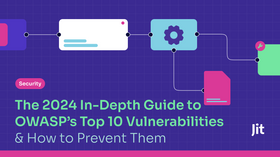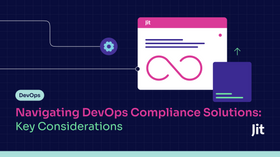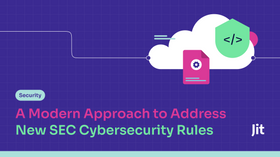10 Application Security Standards to Implement Today
Published October 8, 2025

Security standards only matter when they move from policy to practice. Yet, for too many organizations, they remain words on a PDF while real-world pipelines continue to leak risks. Misconfigurations, unscanned dependencies, and weak access controls remain the root cause of breaches, even though the guidance to prevent them has existed for years. Clearly, the problem isn’t knowledge but execution.
74% of companies have experienced a breach in the past year due to insecure coding practices, with almost half facing multiple incidents. While tools and frameworks abound, 89% of businesses still cite human error as their top cybersecurity hurdle. For today’s engineering leaders, the question isn’t whether standards are valuable, but how to operationalize them in environments where velocity is king.
What Are Application Security Standards?
Application security standards are structured frameworks that define how software should be built, deployed, and maintained to minimize risk.
Some are regulatory (required by law or industry mandates), such as PCI DSS or HIPAA, and set mandatory baselines for industries that handle sensitive data. Others are voluntary frameworks developed by expert communities and widely adopted as web application security best practices. The most popular frameworks include OWASP ASVS, NIST, and CIS Benchmarks.
These standards create a common language among developers, security teams, and compliance leaders. They translate abstract risks into concrete, testable controls, and their relevance in 2025 is higher than ever.
Attackers continue targeting the application layer because that’s where business logic, APIs, and sensitive data live. The shift to cloud-native architectures and API-driven services has widened the attack surface, making misconfigurations and insecure defaults even more dangerous.
At the same time, regulators and customers now expect tangible proof that “security by design” isn’t just a slogan but a measurable practice. In high-velocity DevOps environments, standards are the only scalable way to integrate security into delivery.
10 Application Security Standards to Implement Today
Not every regulation or framework will apply to every business. Some are industry-specific, while others serve as universal baselines. However, these ten represent the most impactful standards that modern engineering leaders should consider.
Legally Enforced Regulations
Legally enforced regulations are mandatory security and privacy requirements that apply when your organization operates within their scope. Non-compliance can lead to fines, sanctions, or even loss of business privileges.
1. PCI DSS v4.0
The Payment Card Industry Data Security Standard is one of the most prescriptive security standards. It governs any environment that handles cardholder data and has 12 requirement families covering network security, data protection, vulnerability management, monitoring, and access control. The move to v4.0 tightened multi-factor authentication, expanded risk analysis, and modernized encryption requirements.
For engineering teams, PCI in the pipeline: builds must never allow unencrypted card data, TLS settings must be continuously validated, and APIs exposed to payment environments must enforce strict authentication.
2. HIPAA
Healthcare organizations and their partners are bound by the HIPAA (Health Insurance Portability and Accountability Act), which sets requirements for protecting the confidentiality, integrity, and availability of electronic protected health information (ePHI).
HIPAA comprises three safeguard categories: Administrative (policies and workforce responsibilities), Physical (facility and device protections), and Technical (access controls, audit logging, transmission security). For healthcare applications, the Technical safeguards are where engineers feel the weight: ensuring all ePHI is encrypted, every access is logged, and every user session is tightly controlled.
The challenge is that HIPAA was drafted long before cloud-native healthcare apps, and today’s engineering leaders must adapt its safeguards to modern architectures and FHIR APIs.
3. GDPR
GDPR, short for General Data Protection Regulation, made “privacy by design and default” a binding legal obligation. Its technical requirements include data minimization, pseudonymization, strong encryption, access governance, and demonstrable risk assessments. Unlike older privacy regimes, GDPR enforcement cuts deep into engineering practices: A debug log capturing email addresses or an IaC template that exposes a storage bucket may qualify as a violation, depending on the context.
Regulators expect ongoing proof that controls work in practice, not just policy statements. That means CI/CD hooks that block code leaking personal data, automated scans for misconfigured resources, and continuous access reviews. GDPR reframes privacy as an engineering discipline: measurable, testable, and subject to regulatory scrutiny.
Certifications and Attestations
These certifications and attestations are not legally mandatory but often contractual or procurement-driven.
4. SOC 2
SOC 2 isn’t law, but it’s often a dealbreaker in procurement for SaaS companies. Built around the AICPA’s Trust Services Criteria - security, availability, processing integrity, confidentiality, and privacy - it requires companies to prove they have controls in place and that those controls actually operate effectively. The emphasis isn’t just on intent but on evidence: auditors expect to see how you conduct access reviews, handle incidents, or manage vulnerabilities.
For engineering teams, this means operationalizing compliance in daily workflows. Access governance must be automated and verifiable, change management must be structured and documented, and vulnerability management must run continuously. Automation helps by centralizing logs across systems, codifying IAM rules as policy, and embedding security checks into CI/CD pipelines.
5. ISO/IEC 27001
ISO/IEC 27001 is the leading international standard for building an Information Security Management System (ISMS) - essentially a framework for how an organization governs security across people, processes, and technology. Instead of dictating specific tools, it defines categories of controls in Annex A, including: access control, cryptography, operations security, secure development, incident management, supplier security, and business continuity. Certification demonstrates that these controls are documented, repeatable, and regularly audited.
Many of its controls tie directly into software delivery practices. Secure coding guidelines, CI/CD change management, vulnerability remediation timelines, and least privilege access all map to ISO requirements. Enterprises often demand certification before signing contracts, so the ability to show automated evidence can make compliance far less painful.
Voluntary Frameworks and Control Catalogs
These frameworks aren’t enforced, but serve as a best practice and are widely adopted.
6. OWASP ASVS
The OWASP Application Security Verification Standard gives developers something most frameworks don’t: a granular, testable checklist of application security requirements. It has three assurance levels covering authentication, session handling, input validation, error management, and cryptographic design.
Unlike awareness lists, ASVS translates directly into developer tasks. You can embed its requirements into code review checklists, test cases, and automated pipelines. Therefore, ASVS is the practical bridge between “best practices” and actionable, verifiable cloud security controls, making it invaluable for teams trying to build security into the SDLC.
7. OWAP Top 10
The OWASP Top 10 is the de facto global language of application risk. Updated every three to four years, it highlights the ten most common and impactful web app vulnerabilities, from broken access controls and injection flaws to SSRF and insecure design. This list also serves as a prioritization playbook for engineering leaders. Training programs, static analysis, dependency scanning, DAST, and penetration tests should all be mapped against these categories to ensure you direct resources where real-world exploits are most likely to land.
8. NIST SP 800-53
The National Institute of Standards and Technology (NIST) is a US federal agency that develops widely used technology and cybersecurity standards. Its Special Publication (SP) 800-53 is one of the most comprehensive security control catalogs in circulation. It groups safeguards into 20 families that span access, auditing, configuration, contingency planning, supply chain, and more. Initially designed for US federal information systems, 800-53 has since been adopted globally as a control reference model.
Aligning CI/CD pipelines, infrastructure as code, and runtime monitoring to selected 800-53 controls provides a defensible compliance story. For example, mapping vulnerability scans to control RA-5 (Vulnerability Monitoring and Scanning) or SBOM generation to supply chain controls translates abstract requirements into day-to-day workflows.
9. SSDF
The NIST Secure Software Development Framework (SSDF) narrows NIST’s guidance to the software lifecycle itself. It focuses on secure design, threat modeling, code scanning, dependency management, artifact signing, and release integrity. Importantly, it doesn’t just recommend practices - it defines them as core to “secure by default” software.
For developers, the SSDF is a playbook for modern DevSecOps. Threat modeling sessions, SAST/DAST in pipelines, signed builds, and SBOM publication all map directly to SSDF practices. With US agencies and buyers increasingly requiring it, SSDF is rapidly shifting from “good practice” toward becoming a procurement prerequisite.
10. CIS Benchmarks
The Center for Internet Security publishes hardening benchmarks for operating systems, databases, containers, and cloud environments. These benchmarks are highly specific: which ports should be closed, which kernel settings should be locked down, and which IAM defaults should be disabled.
CIS Benchmarks are the most practical option for teams under pressure to prove baseline hygiene. Automated scanners can continuously compare Kubernetes clusters, Docker images, or AWS accounts against benchmark profiles, delivering actionable fixes and audit-ready reports. Adopting CIS is often the fastest route to demonstrable alignment with industry standards.
How to Operationalize Application Security Standards at Scale
Most organizations' challenge isn’t deciding which standards to follow but weaving them into the daily reality of software delivery. Even the most robust frameworks risk becoming shelfware if they don’t translate into enforceable controls that developers can work with.
Successful teams approach this as a problem of automation, prioritization, and experience. Automation helps you consistently apply controls without creating bottlenecks. Prioritization filters out the noise, allowing engineers to focus on the issues that matter most to business risk. And developer experience determines whether security guardrails are adopted or bypassed.
One effective strategy is starting with Minimum Viable Security (MVS). Instead of overwhelming teams with every possible control, organisations establish a small baseline of non-negotiables, be it secure authentication, secrets scanning, or branch protection, then expand maturity over time.
Another critical layer is supply chain visibility. Automate SBOM generation and integrate it into CI/CD for a real-time view of what goes into your software. You can then track exposure during events like a new zero-day exploit, and it aligns with compliance expectations from NIST and SLSA.
By codifying controls into Security Plans as Code, Jit embeds policies directly in GitHub or AWS workflows. Developers see feedback in line in pull requests, often with remediation suggestions, making timely and cost-effective fixes.
Jit’s Context Engine then ranks vulnerabilities by exposure and business impact, while its AI agents, SERA (Security Expert Reasoning Agent) and COTA (Contextual Orchestration Triage Agent), improve triage and remediation by filtering noise, surfacing relevant guidance, and adapting prioritization in real time.
Embedding Security That Scales
Application security standards form the backbone of secure development. However, they only deliver value when woven into daily workflows and are not left as a compliance checklist. In 2025, engineering leaders face mounting pressure and unprecedented opportunity to operationalize these frameworks.
For teams ready to move from paper to practice, Jit provides the missing layer: codification, automation, and orchestration. With Security Plans as Code, contextual AI agents, and developer-first integrations, Jit enables organizations to implement OWASP, NIST, CIS, and other standards in ways that keep pace with velocity, without sacrificing coverage or control.
Learn more about how Jit helps organizations scale application security standards from policy to practice.











